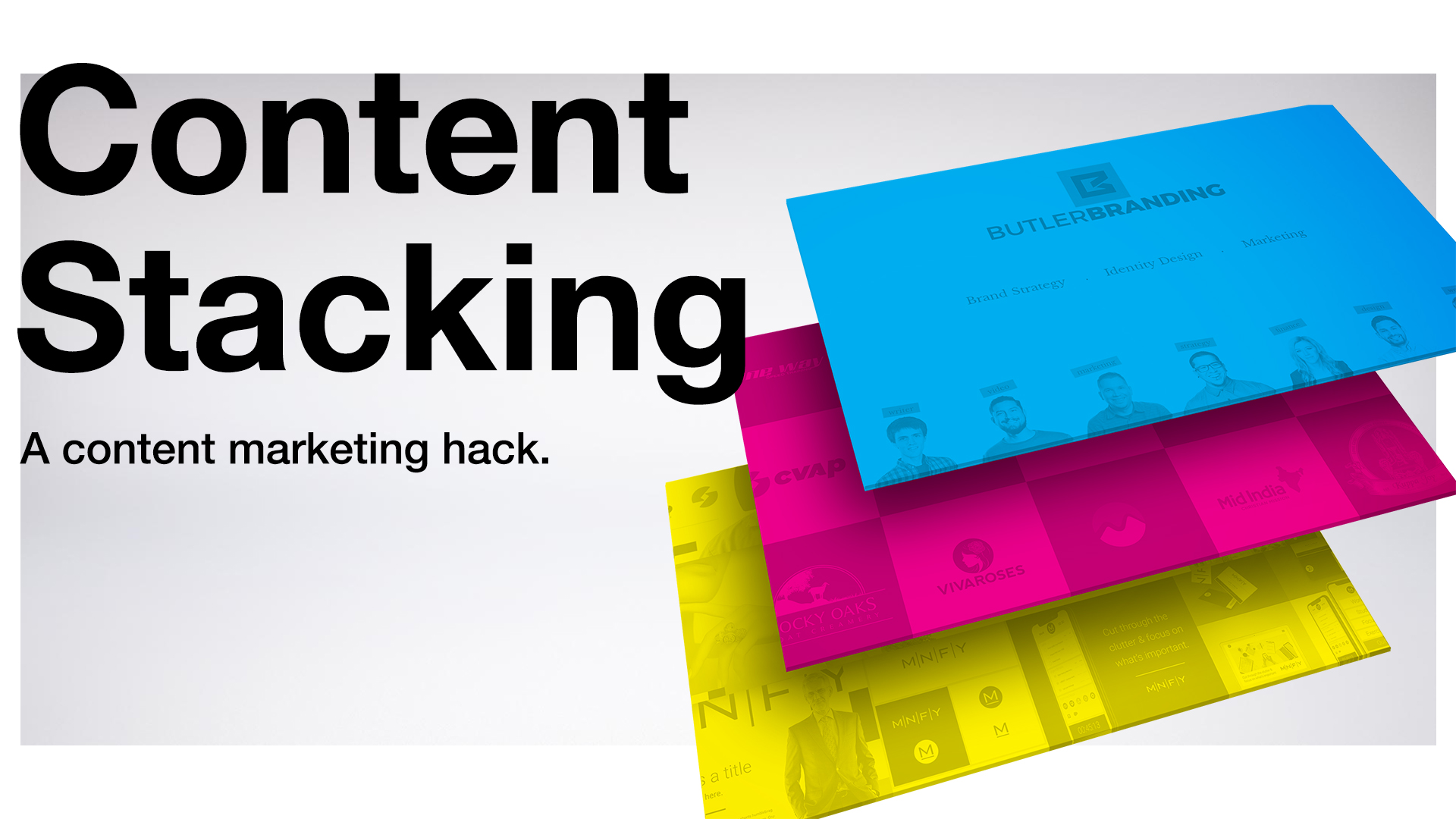No matter what business we talk to about digital marketing, they all seem to say the same things:
- “We understand everyone is using the internet and social media”
- “We recognize the importance of digital marketing”
- “We know that we need to be creating content to share on our website, social media and email”
but…
- “We don’t know where to start”
- “We don’t know what types of content to create”
- “We don’t know what platforms to share our content on”
If you are asking any or all of the above questions, I believe this article will be immensely valuable for you. I’m going to share with you a technique that I’ve incorporated for the last couple of years that has saved me time, money and a lot of creative power. I call it Content Stacking.
What is Content Stacking?
Content Stacking is the process of stacking several small pieces of content (we’ll call this “supporting content”) on top of each other to make one big piece of content (which we’ll call “primary content“). However, in reality, it really works in reverse… you think of one big piece of content (the primary) you’d like to create, such as an e-book, corporate video or annual report, and then think about all the small pieces (supporting content) it takes to create it. In other words, your primary content is the sum of all the supporting content, and you can use the supporting content to share on digital platforms periodically. Using this method of content creation gives you a lot of content without having to think of new ideas all the time – you create a large pool all at once and distribute the pieces sequentially. Below is one example of content stacking that I’ve used for some of our clients (and ourselves) – the e-book:
The E-Book
An e-book is a great way to get inbound leads and build a list by using it as a Lead MagnetA Lead Magnet is a piece of highly valuable content that your target market would want to have so badly that they’d be willing to give up their contact information to obtain… it’s an ethical bribe. (I’ll save this strategy for another post). For the sake of this post, I’ll simply explain my thought process of creating an e-book and how it relates to content stacking. An e-book typically helps it’s readers learn about a particular subject. For example, if you owned a third-wave coffee shop and you wanted to expand your market to up-and-coming coffee connoisseurs (those who like the finer things in life but don’t know much about premium coffee) then you might want to create an e-book called something like “A beginners guide to third wave coffee”. This is the primary content.
You then think about the topics that would need to be covered inside of the e-book. For example:
- An introduction to coffee terminology
- A little history on coffee trends
- How coffee beans go from the fruit to the grinder
- The difference between large chain coffee and artisan coffee
- Different notes/flavor styles
- Different brew method
These topics not only act as sections of your e-book, they would also act as supporting content in your content stacking strategy. For example, section 6 (Different brew methods) could be a blog post that you put on your website, share on social media, and send in your monthly email newsletter. If you really wanted to go crazy with content stacking, you could make even more supporting content by creating sub-sections under this one section. For example “Different Brew Methods” could include an individual post about the french press method, and another one about the pour-over method, etc… For now, though, we’ll just stick with the 6 sections listed above. By creating these 6 pieces of supporting content you can now create a content calendar that alerts you to release one post a month on your website. You can see that this one piece of primary content that you were just going to use as a lead magnet can now be split up into at least 6 months’ worth of blog posts.
You can utilize this strategy for pretty much anything you think would be valuable to the people you’re trying to attract. The cool part is that this strategy is not “salesy” so your audience will feel more comfortable reading it, and it establishes a form of trust between you and your users. It also sets you apart as an expert in your industry as you’re freely giving valuable content that your competition may not be giving. My favorite part of the Content Stacking strategy is that it isn’t taxing on my creativity. Instead of thinking about tons of individual pieces of content to create and share, i just need to think about one piece of content and split it up into individual parts.
“So, where do I start?”
Inevitably, after a post like this people typically say something like “awesome! so… where do I start?” If you want a practical list of homework assignments to get started, here you go:
1. Choose your platforms
Make a list of digital marketing mediums you want to focus on. Don’t deceive yourself into thinking that you’ll do everything great… pick a few platforms and do them well. For sure think about blogging on your website and email, but these are platforms for people who already know about you. Include at least 1 or 2 social media platforms or search engines that give you access to a new audience. Facebook is a must, in my opinion.
2. Brain dump
Take out a piece of paper and just write about things you do, information people need to know, the top 10 questions people have asked you a hundred times, etc. It doesn’t have to be coherent, you’re just making a possible list of things you might want to talk about. Eventually, hopefully you’ll write about all of them, but for now, just pick a couple topics.
3. Outline and create your content
Choose a topic that you think is big enough to split up into several parts, and valuable enough that your audience would want to read it. Start from the macro and work your way to the micro. In other words, think about the primary content first, and then the supporting content that makes it. Write down the list of questions you’re going to answer in each piece of supporting content, including how it’s going to make your users’ lives better.
4. Make a post calendar
A post calendar is simply a calendar that tells you when you’re going to release each piece of supporting content, and on what platforms. It doesn’t have to be anything fancy – it can even be a piece of paper that outlines what and when and which platform. The important part is just sticking to the calendar. Consistency is the key.
Hopefully this helps you! I’d love to hear feedback from you about your ideas on content stacking. Looking forward to seeing what cool creative content you’re able to come up with.
Reach me through Facebook or Snapchat, sending a picture of your content stacking outline.
– Sean T.







